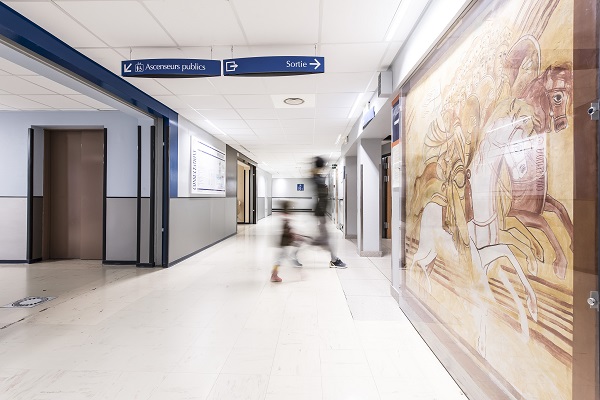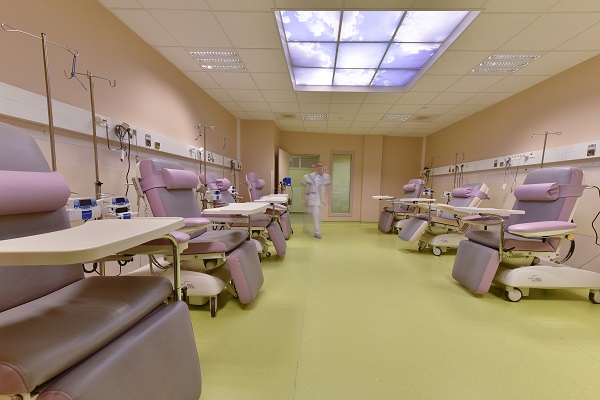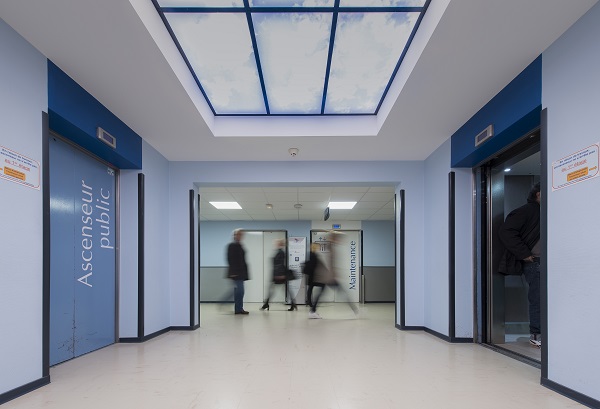The new lighting installation at the university hospital in Poitiers, France supports the treatment of cancer patients in a special room thanks to human centric lighting. A natural environment is being simulated in the room to create a greater feeling of well-being thanks to modern tunable white LED technology and a custom-designed illuminated ceiling. In addition, more than 800 LED luminaires and LED drivers from Tridonic have been installed in the new administrative block at the hospital.
 |
|
(Image: Tridonic) |
The university hospital of Poitiers is the health centre for the entire Vienne region. As part of inter-regional projects and partnerships with other with other university hospitals, it conducts research into medical and therapeutic innovations, improvements to clinical processes and ways to ways to deliver a better patient experience.
Human centric lighting to support cancer treatment
 |
|
(Image: Tridonic) |
Biologically effective light is being used in modern medical facilities to ensure the optimum well-being of patients and provide them with a more pleasant time in hospital. This goes by the name of human centric lighting and covers lighting solutions that boost a patient’s recovery, optimize their sleeping and waking periods and improve their overall well-being. Human centric lighting has recently been installed in the oncology department of the university hospital of Poitiers to improve cancer treatment. Artificial light is being used in a windowless treatment room to create dynamic lighting moods. The installation features QLE PREMIUM modules from Tridonic mounted on the ceiling. Thanks to tunable white technology these square LED modules offer an adjustable colour temperature of 3,000 to 6,000 K at constant luminous flux and a dimming range of 10 to 100 percent without changes to the selected colour temperature. The printed light ceiling shows a picture of the sky. The ceiling luminaire is controlled with the aid of the connecDIM light management system. The LED modules are integrated in the cloud via an internet-capable gateway, which enables decentralised control of the light. The Technical Services department at the hospital used this system to create one hundred predefined schedules with different colour temperatures and dimming levels so that the lighting would mimic the changes in natural daylight throughout the day. Slow movements and changes of colour create the association with a natural sky.
Following positive feedback from patients, doctors and nurses the same lighting system was installed a short time later in front of the lifts on the ground floor where natural light is also absent. The new installation not only creates a brighter and more pleasant atmosphere it also makes navigation easier. Visitors can tell from the image of the sky that they are on the ground floor because this area now differs markedly from the lift areas on the other floors.
 |
|
(Image: Tridonic) |
Innovative LED lighting for the new administrative building
The new administrative building at the university hospital has been equipped with more than 800 SUNA LED luminaires from Tridonic’s partner SFEL. The building brings together all the administration departments under one roof to improve internal processes and coordination. Innovative high-performance lighting technology is reducing energy costs. The linear luminaires installed in the offices, open-space areas and meeting rooms are equipped with LLE G3 LED modules and PREMIUM drivers from Tridonic. The small spacing between the light points ensures that the luminaires produce homogeneous illumination along their entire length. A compact basicDIM control module is fitted in each luminaire. It contains an ambient light sensor which automatically adjusts the illumination according to how much natural light is available at the time. Also integrated in the control module is a motion sensor which automatically switches the light on or off depending on whether or not the workstation or room is currently occupied. This generates further energy savings.
The new lighting solutions can improve the well-being of patients and visitors and also the working environment of the employees. The operators of the new administrative building are benefiting not only from optimum lighting but also from cost savings thanks to integrated sensors.
The university hospital of Poitiers, which is the central health service provider for the entire Vienne region, is a pioneer not only in human centric lighting. It has an excellent reputation in cardiology, oncology, geriatrics, neurosurgery, paediatrics, medical biology and medical imaging. The hospital has a capacity of 1,900 beds at its three sites in Poitiers, Lusignan and Montmorillon.














